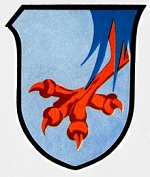Corgi AA36707 German Junkers Ju 88C-6 Medium-Bomber - F1+XM, 4. Zerstorerstaffel/Kampfgeschwader 76, Taganrog, Ukraine, 1943 (1:72 Scale)
"Guns before butter. Guns will make us powerful; butter will only make us fat."
- Reichsmarschall Hermann Goering, Head of the German Luftwaffe
 The Luftwaffe's Junkers Ju 88 was a twin-engine, multi-role aircraft. Among the most versatile planes of the war, it was used as a bomber, close-support aircraft, nightfighter, torpedo bomber and reconnaissance aircraft. A solid aircraft with great performance, it went on to be one of the Luftwaffe's most versatile aircraft. It carried out almost every kind of mission ever imagined, even as a giant flying bomb. It was used in every theater, with many nations, including nations allied against Germany.
The Luftwaffe's Junkers Ju 88 was a twin-engine, multi-role aircraft. Among the most versatile planes of the war, it was used as a bomber, close-support aircraft, nightfighter, torpedo bomber and reconnaissance aircraft. A solid aircraft with great performance, it went on to be one of the Luftwaffe's most versatile aircraft. It carried out almost every kind of mission ever imagined, even as a giant flying bomb. It was used in every theater, with many nations, including nations allied against Germany.
The aircraft's first flight was made by Prototype Ju 88V-1, which bore the civil registration D-AQEN, on December 21st, 1936. When it first flew, it managed about 580 km/h (360 mph) and Hermann Goring was ecstatic. Finally it was something that could positively fulfill the promise of the Schnellbomber, a bomber so fast fighters could not catch it.
Unfortunately, by the time everyone had had their wish list added (including dive-bombing), the speed had dropped to around 450 km/h (280 mph). The draggy fuselage was modeled after its predecessor, the Dornier Do 17, but with fewer defensive guns because the belief still held that it could out-run fighters. It was also very, very late. Planned for 1938, it finally entered service the day the Germans invaded Poland, and then with only 12 aircraft. Production was painfully slow, and problems with such an advanced machine kept cropping up. The Ju 88C series of heavy fighter was also created very early in 1940, but kept secret from Goring because he only wanted bombers.
The Ju 88A-1 series first flew anti-shipping sorties close to Norway. Ju 88 bombers based at Westerland on the island of Sylt in northern Germany carried out the first Luftwaffe raids against Britain. An attack on Rosyth on 16 October 1939, succeeding in damaging three ships, but was then engaged in dogfights by Spitfires of 602 and 603 Squadrons of the RAF and two Ju 88s were shot down in the Firth of Forth. A raid on Scapa Flow the next day saw the loss of one Ju 88 to anti-aircraft fire. All combat-ready Ju 88s (some 133), were pressed into the Blitzkrieg, but very high combat losses and accidents forced a quick withdrawal from action to re-train crews to fly this very high performance beast. By this time it was seen that the A-1 had major performance problems, and an all-out effort was put into a major rework. The outcome was a longer wingspan that was deemed needed for all A-1s, thus the A-5 was born. Surviving A-1s were rewinged to A-5 specifications as quickly as possible.
Pictured here is a 1:72 scale replica of a German Junkers Ju 88C-6 medium-bomber that was assigned to 4./Kampfgeschwader 76, then deployed to Taganrog, Ukraine, during 1943.
Sold Out!
Dimensions:
Wingspan: 11-inches
Length: 7-3/4-inches
Release Date: September 2010
 Historical Account: "The Maid of All Work" - During early 1942, the Ju88C-6 was introduced onto the Junkers Assembly line. This variant was the fighter version of the A-4 bomber and 257 were produced for the Luftwaffe during the remainder of that year. The C-6 was used in both the night and day fighter roles and served on all fronts with many being issued to bomber units to form special Zerstorer Squadrons. Here they flew daylight bomber escort and ground attack missions.
Historical Account: "The Maid of All Work" - During early 1942, the Ju88C-6 was introduced onto the Junkers Assembly line. This variant was the fighter version of the A-4 bomber and 257 were produced for the Luftwaffe during the remainder of that year. The C-6 was used in both the night and day fighter roles and served on all fronts with many being issued to bomber units to form special Zerstorer Squadrons. Here they flew daylight bomber escort and ground attack missions.
Its nose armament of 3 MG 17 machine guns with 800 to 1000 rounds per gun, one MG151 cannon with 350 rounds, or one MG-FFM cannon with 90-120 rounds soon taught allied pilots that different tactics had to be employed when attacking these heavy fighters.
In a bid to trick Soviet fighter pilots into continuing their tried and tested bomber strategy of head on attacks, 4. Zerstorerstaffel/KG 76 painted false 'bomber noses' on their C-6's during the winter of 1942-43. F1+XM served with this unit from the end of 1942 based at Taganrog, in the Ukraine.


